Marlo Morgan—Mutant Message Down Under: Timeline

Wishing you knew more about Aboriginal culture? Search no more.
Get key foundational knowledge about Aboriginal culture in a fun and engaging way.
This is no ordinary resource: It includes a fictional story, quizzes, crosswords and even a treasure hunt.
Stop feeling bad about not knowing. Make it fun to know better.
Mutant Message is a highly disputed book. Here is a timeline of the events, including M. Morgan's apology to the Aboriginal people.
1990: The first book
M. Morgan self-publishes the book for the first time. The title is presumably "Walkabout Woman: Messenger for a Vanishing Tribe" [1][2][3]. The book supposedly has sold 37,000 copies [4][5]. To emphasise support by Aboriginal people Morgan includes a statement by a Yorta Yorta Aboriginal man called Burnum Burnum, described as an activist, actor, author and dreamer. He later retracts in a letter in which he states, "I am a non-initiated, non-traditional, urbanised, Aboriginal from the East Coast of Australia".
1992: No republication, first doubts on author's claims
Stillpoint Publishing of Walpole, N.H., decides not to republish the book when they could not verify the author's claims of having doctorates in biochemistry and oriental medicine, nor her itinerary in Australia, or anything else she claims [1]. The last publication by this publisher was presumably in August 1992 [3]. Stillpoint focuses "on creating books that speak to the very frontiers of spiritual discovery". This publisher puts Morgan's book into the New Age category.
1993: Lectures and speeches
Morgan travels through the United States giving speeches about her book. A rare description of such a promotional evening exists on Native Net.[6]
1994: The hardcover version, opposition starts
28 August
Harper Collins Publishers releases a hardcover edition.[1] A US journalist who has read the press kit "smells a fake" [1] and asks for more information. It is the second edition of the book, which Harper bid $1.7 million to republish.[1][7] Morgan has written a revised introduction to "protect the small band of Aboriginals from legal involvement".[7] The New Age Journal (July/August 1994) reports a growing number of problems with the book[7] and the authors of this article report critical voices such as "rubbish" (Australian journalist Paul Whittaker) and filled "cover to cover" with "fantasies, misinformation, and distortion" (Aboriginal activist Bobby MacLeod).[1] Burnum Burnum's support seems not to be very trustworthy as he "has been associated with a number of 'new age' style enterprises which would not meet the normal criteria of rigorous scholarship".[5]
28 September
Morgan claims that "none of it is made up" in a critical interview with The KUNM Evening Report with Catalina Reyes.[8]
December
Morgan says in the interview that she's going back to Australia in December "to be on a panel with Aboriginal people to face these people that - the white people - who believe that I'm a racist. And to try and solve all of this thing."[8] It is not known whether she actually went. The Common Ground online magazine publishes an interview with Marlo Morgan in its Winter 1994 edition which makes no mention of the controversy (because it is a New Age magazine?).[9]
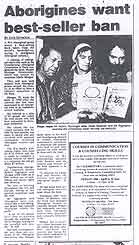
1995: Dumbartung organises Aboriginal resistance
29 March
Aboriginal elders and heads of Aboriginal organisations meet, condemn the book as a hoax and call for it to be withdrawn from sale.[10][11] Meetings extend well into May.
The group around Robert Eggington, head of the Perth-based Dumbartung Aboriginal Organisation, prepares a 90-page document setting out its objections. [12]
21 April
Dr John Stanton, from the University of Western Australia's Berndt Museum of Anthropology, concludes in an expert assessment commissioned by Dumbartung that Morgan's book seriously insults the religious beliefs of desert Aboriginal people. [12] The report has been published on the Dumbartung homepage. [13]

In the same month the Magical Blend Magazine publishes an interview with Marlo Morgan, but this interviewer, too, though acknowledging that there is a controversy going on, skirts around it.[14] Is it because this is a New Age magazine?
1996: Morgan apologises to Aboriginal people, book support retracted
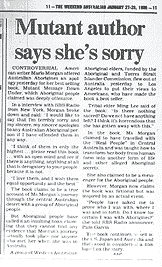
26 January
A delegation of 8 Aboriginal Elders leave for the United States to defend their religion and culture and to block the move by Hollywood executives at United Artists to turn Marlo Morgan's claims into a major motion picture.[16][17] Morgan sells the film rights for U$1.8 million.[12]
31 January
The elders receive an apology. "Morgan admitted for the first time to the eight elders that her work was fiction and a fabrication".[18][17]
I would like to say that I'm terribly sorry and my sincere, my sincere apologies to any Australian Aboriginal person if I have offended them in any way.
— M. Morgan in her apology [15]
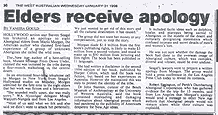
Dr. John Stanton (Berndt Museum of Anthropology, WA) "said the book contained misleading and damaging information about Aboriginal people".[18] He was not sure, he said, "whether the damage the book had done to the overseas image of Aboriginal culture, which was complex, diverse and vibrant, could be ever undone." Morgan promised a written apology, which she actually never produced.[19]
4 March
Burnum Burnum retracts support for Marlo Morgan [20] in a letter to the Dumbartung Aboriginal Corporation.[21]
1997: Aboriginal people protest during lectures in Japan
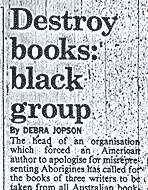
25 March
Eggington calls for "Mutant Message" and the books of two other authors to be taken from all Australian bookshelves and destroyed.[22]
7 April
Dumbartung coordinates protest against Morgan's lectures in Japan. Eggington and a Bardi Elder travel there, give press conferences and appear painted and with didgeridoo and boomerangs at two venues. Morgan comments that "they represent all that is bad, and I represent all that is good". Eggington and the elders leave Japan on April 21st.[17]
18 August
Burnum Burnum dies.[21]
In this year another interview is published in the Golden Age (New Age magazine). Lorraine Mafi Williams, "a traditional teacher and custodian of Aboriginal culture and wisdom" talks about whether the journey was authentic and how the Aboriginal community reacted: "I honestly don't think this woman ever took a walk with anyone except perhaps as a tourist on a tour into the outback."[23]
1998: Morgan publishes a second book
3 July
Harper Collins publish "Message From Forever, A Novel of Aboriginal Wisdom", by Morgan, which she claims "is really written by Aboriginal friends telling me to please do this".
October
phenomeNEWS conducts an interview with Marlo Morgan [24] in which she claims to "have gone back periodically" to the tribe she claimed to have travelled with in the first book. Despite all the uproar there has already been up to that time, phenomeNEWS claim they "were unaware of the controversy surrounding Ms. Morgan and her book" when they did the interview.
1999: Aboriginal people outraged again
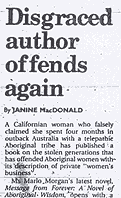
January
Morgan seems not to have learned from the experiences with "Mutant Message". Her new book again outrages the Aboriginal people in Australia. Morgan describes a woman giving birth, but "that is private women's business. For someone to (describe a birth) is insulting and offending to people and their cultural beliefs," says Ms Jo Willmot, chairwoman of the Uluru-Kata Tjuta board of management.[25]
May
Film producer Michael Taylor (together with Barbara Boyle) is said to have "entered into agreements for the production of 'Messenger', based on the best seller Mutant Message Down Under".[26] The production company seems to be nextwavefilms.com, however, to-date the movie was never begun.
2001: Morgan a ghostwriter?
Rocket (apparently a radical mag) reveals "that the author of Pauline Hanson The Truth is none other than Marlo Morgan". Her intention should have been to "hit back" against the discreditation of her book.[27]
2008: Harper Collins apologises for girl's book
While publisher Harper Collins never took any action on the disputed Mutant Message Down Under, they apologised for another book.
Complaints by Aboriginal academics led Harper Collins to apologise for including a section on how to play the didgeridoo in 'The daring book for girls' and to remove it from later editions.[28] Aboriginal people consider it inappropriate for women to use the yidaki (didgeridoo) and believe it makes them barren.
Do you know about another detail? Contact me to update this timeline.
Further information
- Harper Collins Publishers, FREEPOST GW2446, Glasgow, G64 1BR, phone: 0870 0100 441; fax: 0141 306 3750; [email protected]
- Dumbartung homepage, Dumbartung Aboriginal Corporation, 295 Manning Rd, Waterford 6152 WA, phone 08 - 9451 4977, fax 08 - 9356 1823
- ISBNs of Morgan's books
- Stillpoint Publishing